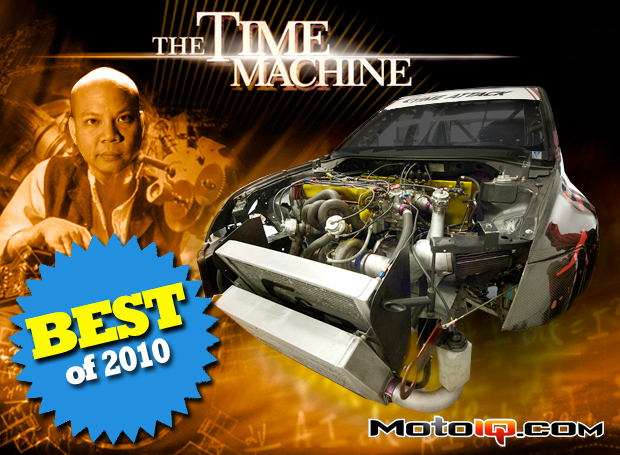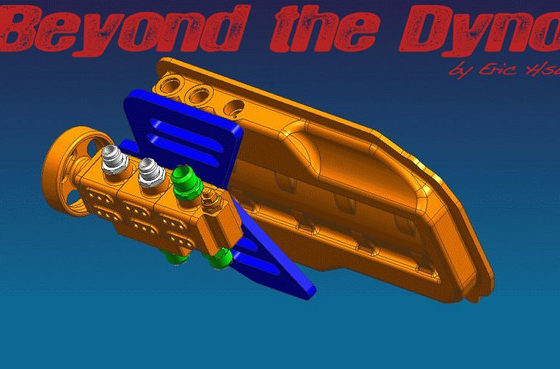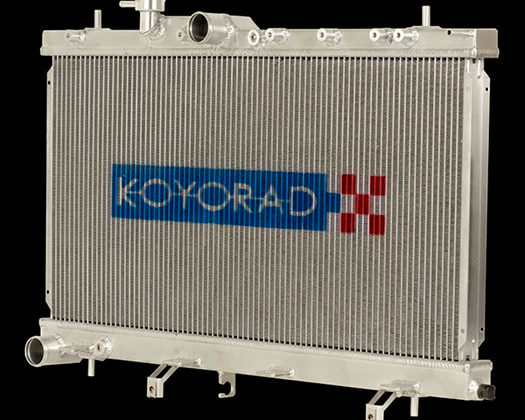,

The EVO rides mainly on Advan RS 18×10.0 +25mm offset wheels when on Hankook Ventus Z-214 C91 275/30/18 DOT tires when at Redline Time Attack and Source Interlink Superlap events. For the World Time Attack Superlap event in Australia, the EVO has tested on Volk TE37 and CE28N lightweight forged wheels that are 18×10.5 with a 22mm offset with Hankook VentusTD C70 295/30-18 DOT tires. In 2009, Sierra Sierra used Yokohama 250/650R-18 slicks for Redline Time Attack events on the Advan RS wheels, but has since amazingly developed the car to be faster on DOTs than the slicks.
 |
| The tri-plane canards provide front downforce. The diverging angle helps prevent flow detachment and creates downforce even though the angle of attack is greater than the 10 degree point of flow separation. The canards also create side vortexes what help reduce air flow under the sides of the car which helps improve the action of the rear venturi. The blunt front end increases stagnation on top of the carbon splitter enhancing its downforce creating abilities. |
 |
| The top view shows the splitter and the belly pan. All dry carbon niceness. |
 |
| What do we have here? The nose section has venturis feeding the low pressure wheel wells. The venturis cause a low pressure depression increasing downforce. Notice the area beside the venturis is also contoured to increase downforce. |
 |
| Functional ducts in the nose channel air to the front brakes. |
 |
| Dry carbon duct directs air directly from the front end to the huge oil heat exchanger. Ducts more than double the effectiveness of heat exchangers. |
 |
| Dry carbon ducts in the nose and chassis direct air through the big C&R radiator and the Cosworth intercooler. |
The all important bodywork and aero package is a mix of Kaminari parts modified by Sierra Sierra to be functional to produce plenty of downforce. The front Kaminari nose has a blunt flat face to maximize stagnation of the air flow on top of the ample stiff carbon splitter. The splitter leads to a belly pan with diffusers leading to the low pressure wheel well to maximize front downforce. Dual front canards are integrated into the front splitter; these create some downforce and generate vortexes that keep air from flowing under the sides of the car at speed.
 |
| These carbon barge boards are used to improve the effectiveness of the Kaminari side skirts. They prevent the air flowing around the sides of the car from flowing underneath the car which could disrupt the flow of air through the rear diffuser. They are also a surface where a pressure differential can exist to improve downforce. |
 |
| This small Gurney on the trunk deck lid does several things, it helps activate the flow through the rear diffuser as well as slow the air under the wing increasing its efficiency. |
 |
| The carbon hood has functional vents where the radiator and intercooler's hot air can be vented over the car improving downforce and reducing drag instead of backing up inside the engine compartment. |
 |
| The car has a flat bottom for excellent undercar air management. The strakes help make sure that the diffuser is fed a laminar air flow even under different angles of attack experienced in cornering. They help keep the amount of downforce that the diffuser can create consistent as the car goes around turns. |
The air flowing through the front mount intercooler and the radiator is guided through ducts to the top of the car's body. This contributes to downforce and reduces drag. It also improves cooling. The car has a flat bottom leading to a rear carbon diffuser which features stakes to generate vortexes to enhance the diffusers effectiveness at different flow aspect angles and angles of chassis pitch. The diffuser has twin double deck elements on the side's ala current DTM cars to increase the diffusers effectiveness by increasing diffuser area and allowing the use of a deeper included angle without flow detachment.
 |
| The Sierra Sierra EVO probably has the most sophisticated undercar aero of any current time attack car. The multi tiered diffuser is designed to get the most possible downforce out of every square inch of the back of the car. The center tier is shorter and shallower to avoid flow separation. It is shorter because it must clear the rear differential. The sides are deeper because they extend further forward. The outermost elements have a twin deck because they are shorter due to the rear wheelwells and the double deck allows a shorter diffuser section to work better. The strakes in the diffuser generate vortexes which causes the flow in the diffuser not to separate increasing its effectiveness. |
 |
| Because the diffuser area near the rear wheels must be very short due to the wheel wells, a double deck is used. The shortness means that it is hard to maintain the 7-10 degree angle needed to reduce flow separation. The second deck allows another 7-10 degrees of the upper deck over the lower deck so the overall diffuser angle can be steeper with less separation and more effectiveness. |
An APR wing on the rear deck connected to the chassis via custom fabricated stays adds an adjustable element to the rear downforce. Kaminari side skirts with Sierra Sierra fabricated carbon barge boards help keep the airflow from curling under the car to disrupted flow to the rear diffuser. The hood, wide fenders, doors and rear deck are all carbon fiber from Seibon and save about 100 lbs. APR carbon aero mirrors round out the car's body package.
 |
| The APR rear wing is used as a tunable element to the car's downforce. |
 |
| Because the wing creates several hundred lbs of downforce and the consequences of a wing failure can be disastrous, sturdy wing mounts are a must. |
A race car like the Sierra Sierra EVO is an always evolving piece. This is a snapshot of how the car sits right now, a week after the Redline Time Attack in April 2010. The team is always testing and developing and is in the process of making more changes before the car gets loaded on a plane for the upcoming World Time Attack in Australia where Sierra Sierra will proudly represent the USA and battle the fastest Time Attack cars from Australia and Japan. Stay tuned and we will keep you posted on future developments and results of the Sierra Sierra time machine.




